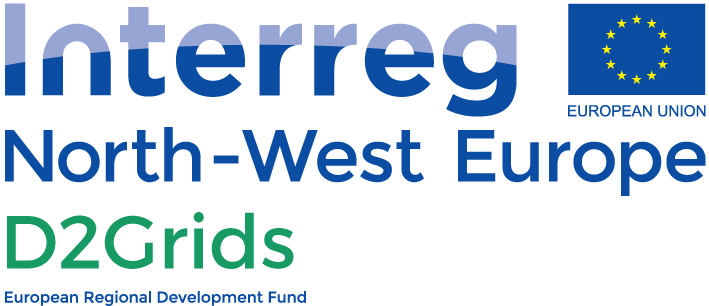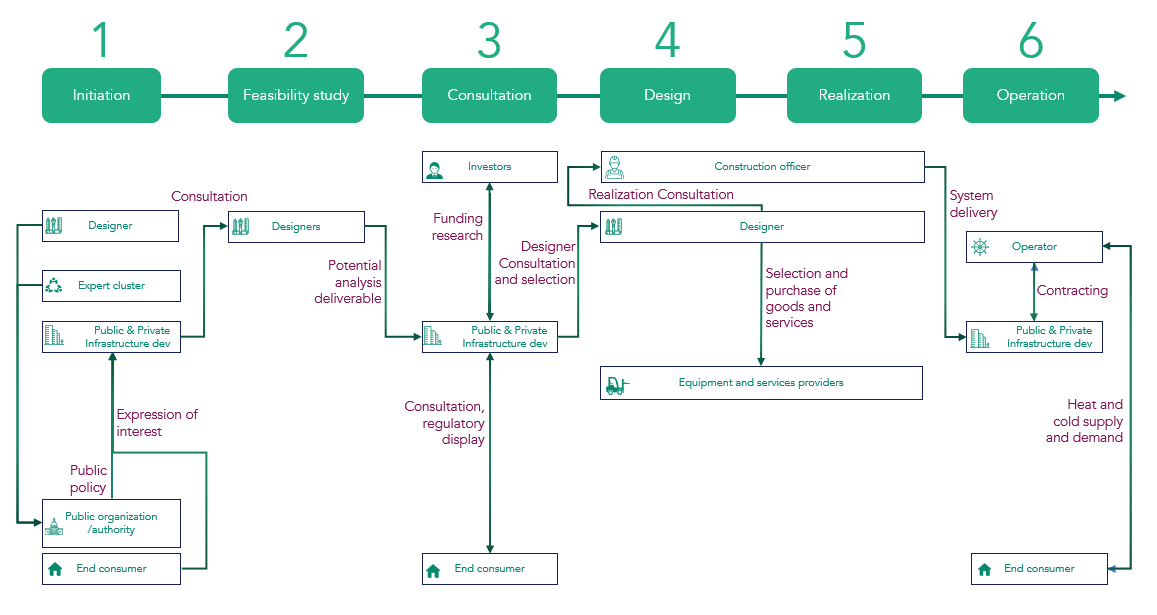How to launch a DHC network project in your territory?
1 – Initiation:
A district heating and/or cooling project can be identified in different ways:
- A territorial transition plan aims to enhance energy efficiency, to increase the share of renewable/waste energy or to reduce the energy bill of households. The local authority is seeking to develop a district heating network.
Example: if a local authority has a Climate and Energy Plan that aims to increase the share of renewable energy to 50% for heating on its territory: An effective action would be to deploy a heating network in one of the municipalities with a high rate of renewable energy.
- A source of renewable/waste energy has been identified on the territory. This free source of energy can be valorised through a district heating network.
Example: An industrial company has a surplus of low temperature heat (30°C) and does not know how to use it onsite.
- A new need for heat/cold on a territory (new district, new hospital…)
Example: A new district is built and seeks to be supplied with a renewable and competitive energy. This new network can also supply other buildings or districts.
Then, to help better define the scope of the project, an opportunity study can be conducted to determine several outputs:
- Who will be the project owner/project manager?
- What will be the scope of the project?
- Which type of sources are available?
- What would be the energy density of the project?
To secure its project and reduce the risk related to the investment, the project owner will seek for energy intensive customers, like hospital, schools, swimming pools or industrials.
2 – Feasibility study:
If the potential identified is considered as enough, the project owner can decide to continue the studies with a feasibility phase. This study aims at determining several elements :
- Energy balance (estimation of energy needs, selection of local energy sources, definition of scenarios)
- Choice and sizing of installations (production, distribution, delivery stations, thermal storage)
- Economic assessment (investment, subsidies, estimated costs and revenues)
- Environmental and social impact (ENR&R rate, CO2 impact, stimulation of the local economy)
- Expected planning
The designer evaluations must be based on knowledge on the potential demand, on the local resources (geothermal, biomass…). To rapidly deploy 5GDHC, this new technology must be considered from the early stage of the project.
3 – Consultation:
Governance mode:
As local authorities are the owners of the roads in a city, they are the key player in DHC networks. Different modes of governance exist, the local authority can:
- Delegate to a private company the construction and operation of the DHC. In this case the investment is made by the private company.
- Delegate only the operation of the network to a private operator.
- Ensure the construction and operation of the network
Funding is a major issue in DHC (District Heating and Cooling). Investors are reasonably not confident enough in projects which economic viability has not been demonstrated yet. The decision making of financing is generally based on risks evaluations. Furthermore, 5G technology is more expansive than usual grids (low temperatures, electrical/thermal coupling…).
The investment in the network can be made either by the private developer or by the municipality or by both, depending on the contracting scheme.
4 – Design phase:
The design phase includes all the studies to be performed before project construction starts. These studies can be conducted either by the project owner (private developer or local authority) or can be outsourced to a dedicated company through a call for tenders.
This phase includes:
- Plans and documents for the design and implementation of the installations,
- Technical specifications of equipment and works,
- Installation drawings for energy sources, substations, piping, instrumentation, electricity, and civil engineering,
- Functional analysis and regulation rules,
- Plans and technical documents related to any application for authorization and permit (including building permit and application) and any declaration and certificate for the project.
5- Construction:
In general, the project owner (private developer or local authority) designates an entity in charge of the implementation of the network after a call for tenders. This entity will separate the construction work into different lots and organize call for tenders to select one or several companies for each lot.
Each company will then conduct detailed study on their respective lots and will oversee the execution of the works.
The entity in charge of the implementation will follow the execution of the work of each lot.
After the commissioning and acceptance of the work, the network is ready to operate.
6- Operation:
The grid can be operated either by the local authority or by a private operator.
The network is in charge to supply heat and cold to every customer connected. A DHC is demand driven. To allow a better amortization of the investment on the infrastructures, the grid operator will seek to connect new costumers all along the duration of the grid.
The operator will also oversee the maintenance of the grid, substation, and production units.
As 5GDHC is a distributed power generation, supply, demand, and payment procedures could be disrupted by new technologies. Consumers could have to be more active, new business models must be identified and new players will probably appear.

